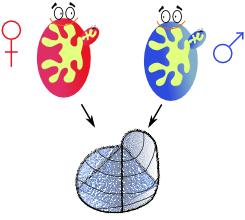Liliana Milani and Fabrizio Ghiselli
Most eukaryotes transmit their mitochondrial DNA (mtDNA) maternally. It is thought that this functions to maintain compatibility between nuclear DNA and mitochondrial DNA; indeed, it is known that coexistence of two healthy haplotypes can reduce the fitness of a cell. It has been proposed that a division of labour exists between the male and female germ lines: egg cells act as genetic vaults to pass on mtDNA, and so are energetically quiescent to avoid generating reactive oxygen species (ROS) which may damage their mtDNA. Sperm cells, by contrast, would have highly active mitochondria to maximize their motility, at the sacrifice of their mtDNA.
There are, however, rare organisms which undergo doubly uniparental inheritance of mitochondria (DUI), for instance the Manila clam (R. philippinarum). Females are generally homoplasmic in their haplotype (F) whereas males also have a second haplotype (M). Male somatic tissue is heteroplasmic in M and F, whereas their sperm are homoplasmic for M. In this study, the authors examine evidence for the "division of labour" hypothesis, by studying mitochondrial activity in the germ line of R. philippinarum.
Through electron microscopy, transcriptional analysis and membrane potential studies, the authors did not find evidence for mitochondrial quiescence in either germ line. The authors thus claim that this is evidence against the division of labour hypothesis more generally across eukaryotic life, and that energetically-competent germ cells may be selected for during gametogenesis/fertilization (see here for recent work in our group on this). This contribution adds to a growing body of literature which questions that ROS is "the root of all evil".
Through electron microscopy, transcriptional analysis and membrane potential studies, the authors did not find evidence for mitochondrial quiescence in either germ line. The authors thus claim that this is evidence against the division of labour hypothesis more generally across eukaryotic life, and that energetically-competent germ cells may be selected for during gametogenesis/fertilization (see here for recent work in our group on this). This contribution adds to a growing body of literature which questions that ROS is "the root of all evil".

No comments:
Post a Comment
Note: only a member of this blog may post a comment.